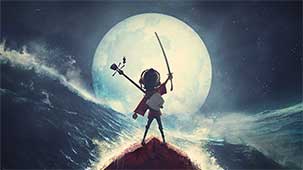To remember the first stop-motion animation I experienced requires I regress to about five or six years old--which would ballpark the year around 1967 or so. The film was Ray Harryhausen’s The 7th Voyage of Sinbad and the wonder of watching what I believed at the time was a real centaur square off with an equally real dragon made a profound impression on my little psyche. So much so that I have remained fascinated with the constantly evolving bestiary of fantastic creatures that populate every culture’s myths and popular entertainments.
Later in life I became obsessed with all aspects of Japanese culture I could access, which in the pre internet age wasn’t a fraction of what is available now. But that dearth of material meant I ended up studying medieval Japanese history in university, mostly as a means to sate my obsession.
Kubo and the Two Strings, which builds upon and then surpasses, technically at least, Harryhausen’s earlier stop motion/real world hybrids, masterfully incorporates elements of Noh theatre, Shinto (an animistic worldview that some describe as religious but I think is more properly described as a philosophy) Japanese wood block carving, origami, and a Samurai aesthetic. All of these art forms are integrated within a story that feels uniquely Japanese and contains various mythic elements specific to that culture.
That meant that Kubo and the Two Strings occupied a space in a Venn diagram that, for me at least, that can only be described as the sweetest spot. Of course it also meant that my expectations for this film would be hard to meet. Wanting a film to be a particular thing, instead of just allowing it to be whatever it actually is, usually ends in tears. However, you managed to not only meet, but exceed my expectations.
Stop motion animation, when done correctly, has a tactility and depth that even 3D rendering can’t match. Combine that with a spare but achingly beautiful aesthetic, superior voice talent, and a story that plumbs surprising depths, and you end up with a film that fulfills the promise of your earlier works. Films like Coraline, Paranorman, and Boxtrolls particularly, all manage a veracity and depth of character that I frankly find lacking in most Pixar stuff. There is a groundedness that makes the characters feel less like walking allegories and much more like real people facing extraordinary circumstances.
Unlike the overt and sometimes didactic offerings of much of English language animation, your work simply tells a fantastic story, and allows the audience to draw their own conclusions from the subject matter. Kubo and the Two Strings is the platonic ideal of “show, don’t tell” because the story is told through the character’s actions and the details of the world building rather than through long expository moments or neon limned (in the case of Inside-Out, literally neon limned) Spielbergian archetypes. Kubo and the Two Strings is filled with unexpected tragedy, sharp narrative turns and a tension that is often missing from other works in this genre.
As with recent works like Netflix’s Stranger Things this is a story that features children prominently, but isn’t necessarily made for children. Kubo and The Two Strings, while perfectly consumable as an adventure story, is sophisticated enough that it will engage anyone with the interest in seeing it.
Kubo and the Two Strings feels like a step forward, rather than just another animated film. It will be interesting to see where you go next, and whether others will follow.
Sincerely,

Tim






